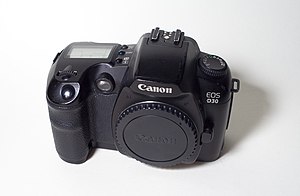 | |
| Overview | |
|---|---|
| Type | Digital single lens reflex camera |
| Lens | |
| Lens | Interchangeable (EF) |
| Sensor/medium | |
| Sensor | CMOS |
| Maximum resolution | 2,160 x 1,440 (3.1 megapixels) |
| Film speed | 100-1600 in 1 EV steps |
| Storage media | CompactFlash (CF) (Type I or Type II) and MicroDrive (MD) |
| Focusing | |
| Focus modes | One-shot, AI-Servo, AI-Focus, Manual |
| Focus areas | 3 points (1 + 1) |
| Focus bracketing | none |
| Exposure/metering | |
| Exposure modes | Full auto, programmed, shutter-priority, aperture priority, manual |
| Exposure metering | TTL, full aperture, zones |
| Metering modes | Evaluative, Center Weighted, Average |
| Flash | |
| Flash | built-in, pop-up |
| Flash bracketing | none |
| Shutter | |
| Shutter | electronic focal plane |
| Shutter speed range | 30 to 1/4000 s |
| Continuous shooting | up to 3.0 frame/s, max 8 frames |
| Viewfinder | |
| Viewfinder | Optical |
| Image processing | |
| White balance | 7 presets, including Auto and custom |
| WB bracketing | none |
| General | |
| LCD screen | 1.8 in (46 mm), 114,000 pixels |
| Battery | Li-Ion BP-511 rechargeable |
| Optional battery packs | BP-511A, BG-ED3 battery grip |
| Weight | 780 g (body only) |
| Made in | Japan |
| Chronology | |
| Predecessor | Canon EOS D2000 |
| Successor | Canon EOS D60 |
The Canon EOS D30 is a discontinued 3.1-megapixel professional digital single lens reflex camera (DSLR) body, initially announced by Canon on May 17, 2000. It is part of the Canon EOS line of cameras and uses the EF lens mount. The EOS D30 was Canon's first "home grown" digital SLR.[1] Before that point Canon had a contract with Kodak to rebrand the Kodak 2-megapixel DCS 520 as Canon EOS D2000 and the 6-megapixel DCS 560 as Canon EOS D6000 digital SLRs, which combined Kodak digital backs and Canon camera bodies.[2]
The D30 was succeeded by the 6.3-megapixel D60 in 2002.
- ^ "Canon EOS D30 Digital SLR". imaging-resource.com. August 27, 2000. Retrieved 19 November 2009.
- ^ "Canon EOS D30". Steves Digicams. October 27, 2000. Retrieved 19 November 2009.